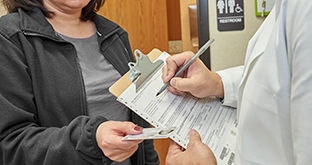Transport Safety Editor — J. J. Keller & Associates, Inc.
What are the DOT Requirements for Drug Testing?
Learn about the six required DOT drug tests and procedures for addressing drug-testing violations.
Published On: 08/01/2024


Written by:
Kathy Close
The requirements for DOT drug testing are outlined in 49 CFR Part 382 and drivers operating commercial motor vehicles (CMVs) requiring a commercial driver’s license (CDL) are subject to these regulations. Procedures for administering the drug tests are outlined in 49 CFR Part 40. The regulations require laboratory analysis of a urine or oral-fluid (saliva) specimen for the presence of the following drugs:
- Marijuana metabolites
- Cocaine metabolites
- Amphetamines
- Opioids
- Phencyclidine (PCP)
Only laboratories certified by the Department of Health and Human Services may be used.
Six Required DOT Drug Tests
The regulations require the following DOT drug tests:
- Pre-employment
- Post-accident
- Random
- Reasonable suspicion
- Return-to-duty
- Follow-up testing
PRE-EMPLOYMENT
A negative pre-employment test result must be received before the driver operates a CMV requiring CDL.
POST-ACCIDENT
Required for an accident meeting the criteria prescribed in §382.303 while operating a CMV requiring a CDL. In post-accident testing, the use of police drug tests may be used in lieu of a motor carrier test where police will make results available.
RANDOM
The minimum annual random drug testing rate is 50 percent. In other words, the number of completed random drug tests must equal at least 50 percent of the average number of driving positions at the carrier over the course of the calendar year.
REASONABLE SUSPICION
Requested of a driver when a trained supervisor observes physical, behavioral, speech, and performance indicators of probable use of drugs.
RETURN-TO-DUTY AND FOLLOW-UP
Drivers who fail a drug test, or violate the prohibitions against using drugs, are subject to return-to-duty and follow-up testing.
DOT Procedures Following a Drug-Testing Violation
A DOT drug-testing violation can include a positive, adulterated, or substituted test result, a refusal to test, and actual knowledge by the employer of drug use.
First, the driver must be removed from safety-sensitive functions. The employer must then advise them of resources available in resolving a drug abuse problem.
The driver must be evaluated by a substance abuse professional (SAP) who determines what assistance is needed. The driver must be evaluated again after treatment by the SAP to determine whether the program was followed appropriately. If the SAP feels the driver may return to duty, he or she will issue a report to the motor carrier outlining the follow-up program.
This letter allows the motor carrier to request a return-to-duty test (performed under direct observation). Before a driver returns to duty, he or she must pass the drug test.
The driver must also submit to at least six unannounced follow-up tests, also performed under direct observation, in the first 12 months following return to duty. The SAP can prescribe follow-up testing up to five years.
Are you compliant with Drug & Alcohol Clearinghouse requirements? Download our Clearinghouse Checklist for details on how to comply.
You may also enjoy the following articles:
Sign up for our newsletter!
We'll help you stay on top of regulations, best practices, and fleet industry news. Sign up to receive a monthly email notification with links to our most recent blog articles, free resources, and event invites.
